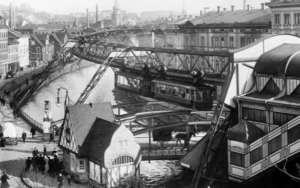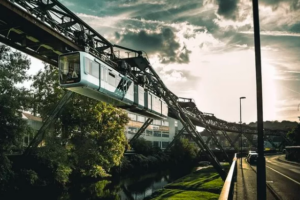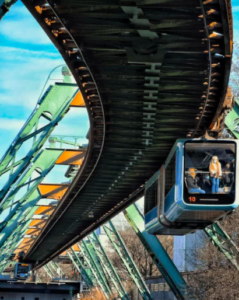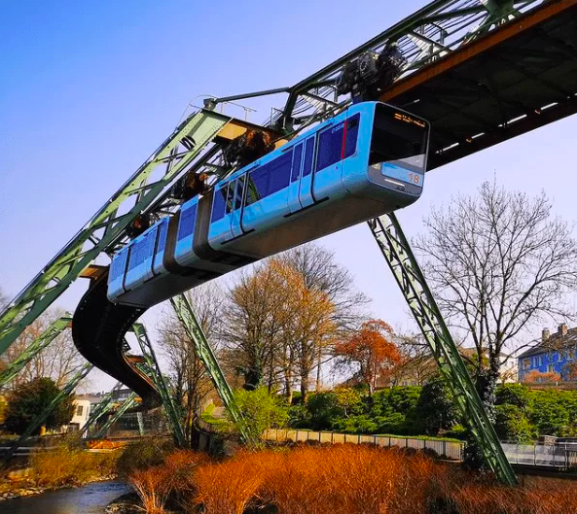In the city Wuppertal, in the north of German, there is Schwebebahn, a subway very different from the one that we are accustomed to use every day. This line is hanged, as suggest its name that literally means “hanging railway”. What is the history of this extravagant means of transportation?
The hanging railway: a subway up in the air
# The construction of the hanging monorail: a futuristic idea fulfilled in 1901

Even though the idea of a hanging railway can seem futuristic and visionary, the first construction proposal came in 1824. The project was then set aside, perhaps because it seemed too risky, but by the end of XIX century the idea was resumed, so the building of the hanging monorail, powered by electricity, started.
With a cost of 16 million Goldmark, the currency of German empire at the time, the line was inaugurated in 1901 in the presence of the emperor Guglielmo II. Today the railway is still in function, counts 23 stops and it is the most important means of transportation in the city.
# 23 stops: the railway is the most important means of transportation in Wuppertal

The Wuppertal Scwebebhan is for sure one of the first hanging line of the history. The train convoys are hanged to a rail, that is placed on a supporting structure elevated from the ground. The vehicle, contrary to the ordinary lines, travels under the track instead of above it.
The monorail Schwebebahn is built on an iron bridge that is 13,3 km long and between 7 and 13 meters high. Even today, it is still the city’s most important means of public transportation since it offers both fast transfers and a unique and spectacular view.
# The mortal accident and the wired story of Tuffi, the fallen elephant

The line is considered one of the safest vehicles in the world, the probability of going out of the track is almost zero. When facing the curves, the wagons gently recline to avoid possible tugs and falls of passengers, for this reason the number of accidents is very low. However, there have been a couple of them that are worth mentioning.
The first one, surely the most tragic, happened in 1988, when a metallic object that was stuck in the rail caused the derailment of a wagon in the river below. The toll was five victims and 49 injured.
The second accident, instead, was certainly bizarre, such that it became part of the popular history of Wuppertal. In July 1950, Althoff Circus decided to put a young elephant named Tuffi on the monorail, to promote a show. But the poor animal was so terrified that went out through the side wall of the train and fell for 9 meters. Luckily, in that moment the wagon was above the river that allowed the elephant a lucky landing, saving her life. This unusual and odd story is remembered today both by a mural, located on a building near the place where Tuffi fell, and a children book, titled “Tuffi and the hanging railway”.
CHIARA BARONE











